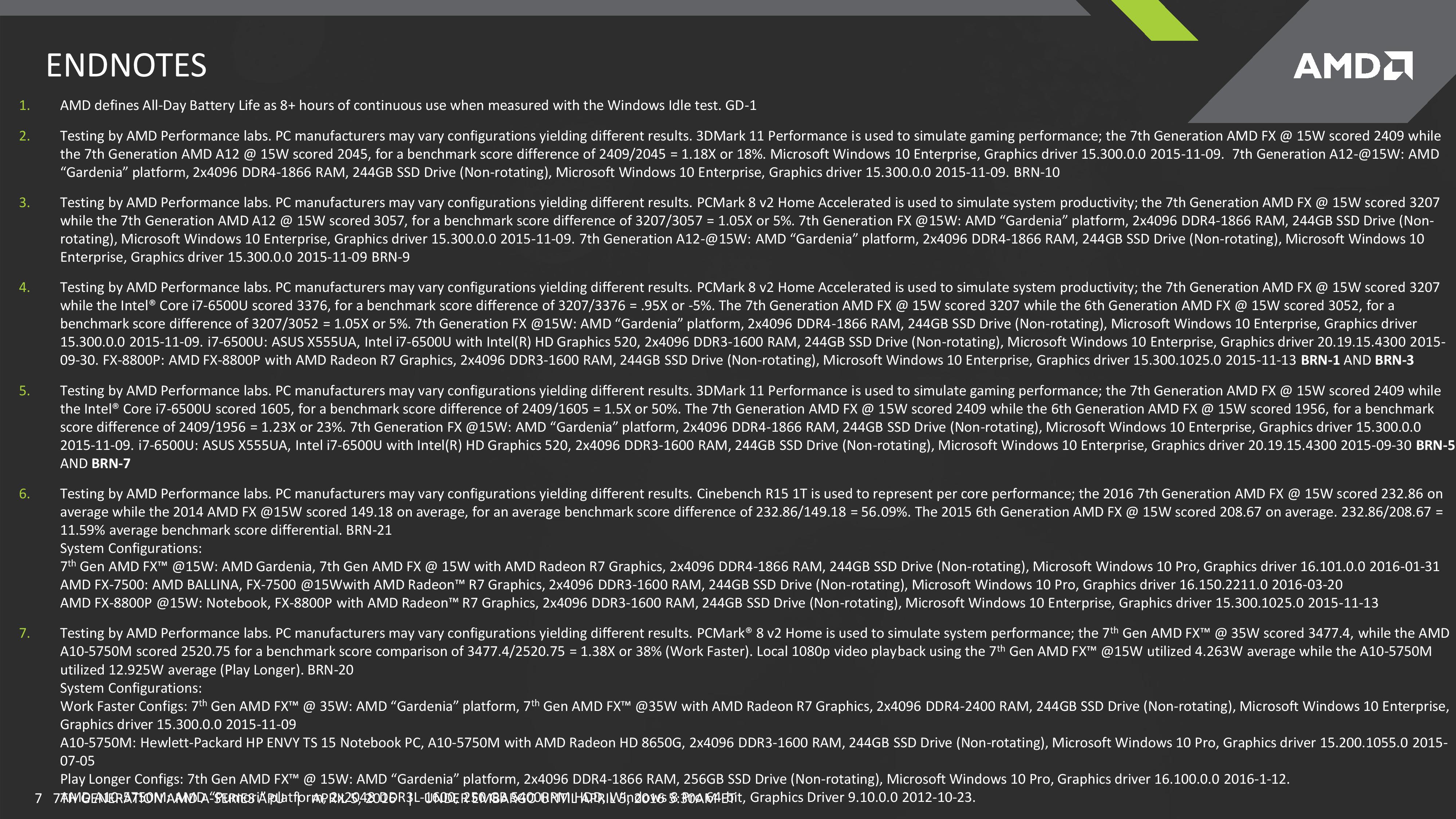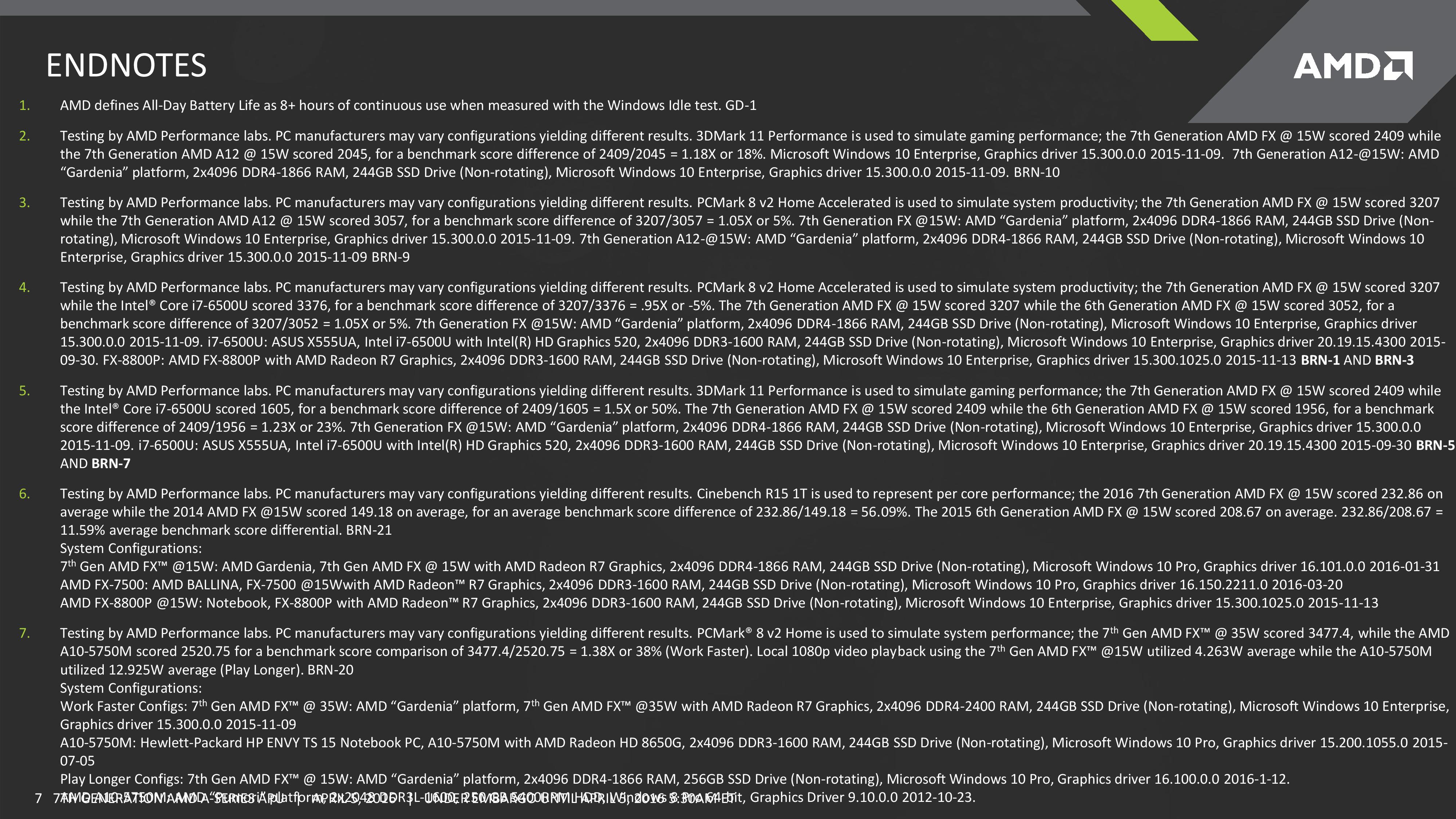Those are 15W TDP scores and not 35W TDP ???
Do we have a link for that ??
I just edited my previous post...
Note 6.

http://wccftech.com/amd-bristol-ridge-apu-computex-launch/
Those are 15W TDP scores and not 35W TDP ???
Do we have a link for that ??

I just edited my previous post...
Note 6.

http://wccftech.com/amd-bristol-ridge-apu-computex-launch/
Those values don't add up. Checking this page shows that a 15 W 8800P scores around 207 in C15 MT. What that image shows is in fact the MT performance for 15W BR and Carrizo, not 35W. A 8800P with that TDP scores 277.
Furthermore, check out the sixth endnote. It's clear they only compare 15W SKU's when it comes to multi-threaded performance.
However, the ST performance seems to add up from checking the first link. Quite a bit higher than Carrizo, and that is without considerig that the top of the line BR (9830P) has got a higher base and turbo clock than the tested 9800P (if they indeed compared the 9800 against the 8800 in ST performance).
Could be wrong, but doesn't any 8800P SKU max out at 3.4 GHZ, no matter its TDP ?
Just realized that 35W Bristol at 28nm HDL has the same performance as the 22nm Haswell Core i3 4000M at 37W TDP in Cinebench R15 both Single and Multi.
http://www.hardwarecanucks.com/foru...md-details-bristol-ridge-am4-performance.html


Core i3 3110M 35W TDP 22nm
http://www.notebookcheck.net/Intel-Core-i3-3110M-Notebook-Processor.74459.0.html
Cinebench R15
Single = 81,5
Multi = 209
Core i3 4000M 37W TDP 22nm
http://www.notebookcheck.net/Intel-Core-i3-4000M-Notebook-Processor.93560.0.html
Cinebench R15
Single = 94,2
Multi = 239,8
M tier is NOT a bottom of the barrel compared to the U chips.That i3 is bottom of the barrel in both efficiency and performance. i5 6500u scores 120 in a 15 watt tdp. Maybe AMD is catching up though. At least now you are comparing to haswell instead of ivy bridge.
That i3 is bottom of the barrel in both efficiency and performance. i5 6500u scores 120 in a 15 watt tdp. Maybe AMD is catching up though. At least now you are comparing to haswell instead of ivy bridge.
Well, the performance is extremely close to 14nm Skylake Core i3 6100U. This is an engineering marvel, 28nm CPU almost equals 14nm CPU at the same TDP in a very Intel optimized benchmark. If BristolRidge was made at 14nm LPP the performance/watt would skyrocket.
http://www.notebookcheck.net/Intel-Core-i3-6100U-Notebook-Processor.149441.0.html
Core i3 6100U 15W TDP 14nm
Cinebench R15
Single = 97
Multi = 247
Well, the performance is extremely close to 14nm Skylake Core i3 6100U. This is an engineering marvel, 28nm CPU almost equals 14nm CPU at the same TDP in a very Intel optimized benchmark. If BristolRidge was made at 14nm LPP the performance/watt would skyrocket.
http://www.notebookcheck.net/Intel-Core-i3-6100U-Notebook-Processor.149441.0.html
Core i3 6100U 15W TDP 14nm
Cinebench R15
Single = 97
Multi = 247
Yeah, but Carrizo has significantly more resources.
If you wish to really compare the apples to the apples, then you must test with CMT and SMT technologies disabled on both designs.
However I do agree that those results posted for Carrizo are completely *ucked up:
15/25W = 215
20/25W = 217
25/25W = 238
30/30W = 255
35/42W = 267
Those are the correct values for XV.
Those cinebench results in the hardware canuks article are at 35watts. It is shown as 35 watts on the graphs and stated very clearly again in the text. Additionally, they were not even verified by the author, but were numbers provided by AMD.
The CB R15 scores are for 15W TDP taken from the AMD slide bellow.
http://images.anandtech.com/galleri...e-007.jpg?_ga=1.7364530.1459516107.1438938042
That is not what the article says or the graphs show.
Directly copied and pasted from the posted link:
"There is however a small caveat here: all of the solutions were pushed to their 35W maximum so it is quite likely they’d still be overcome by the 15W i7-6500U from previous benchmarks which levels out around the 127 mark."
But in any case, I dont think you can accurately compare AMD provided benchmarks on who knows what kind of platform to Notebook check data from a real world shipping platform.


How is the power measured in the graph above..?.
What generation of intel hardware is this close to in terms of efficiency?They are read from the PMC using tools intended for evaluation. There are hundreds of parameters that can be monitored and logged, and they are accurate. That's the reason why Excavator can be as power efficient.
What generation of intel hardware is this close to in terms of efficiency?
Also do have any idea how much changed with br eith the tweaked manu process?
Sent from my SM-G930T using Tapatalk


